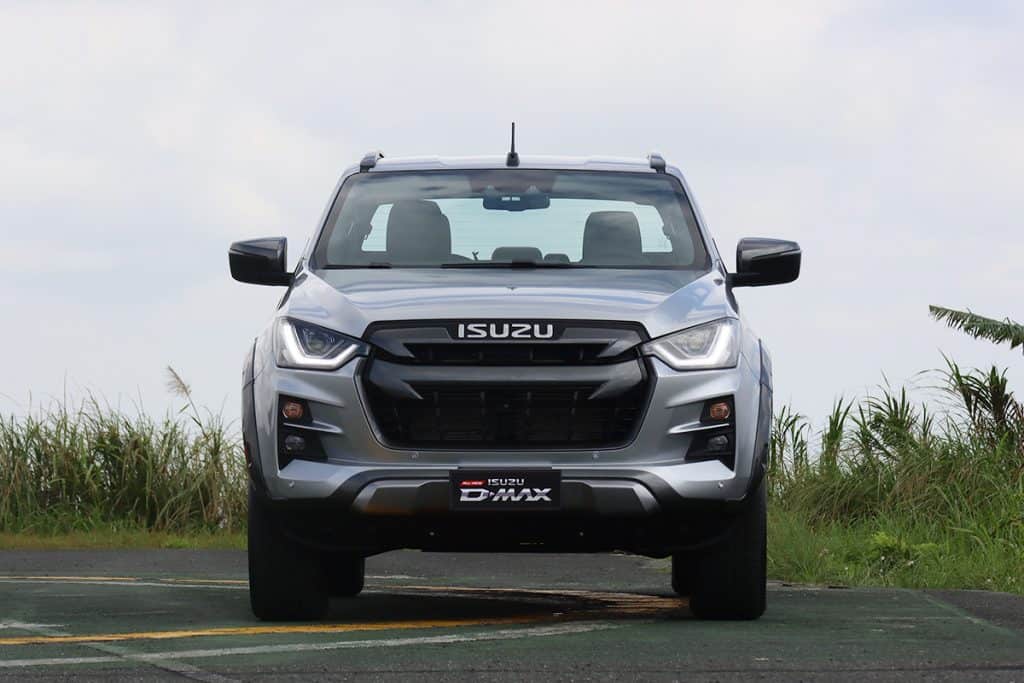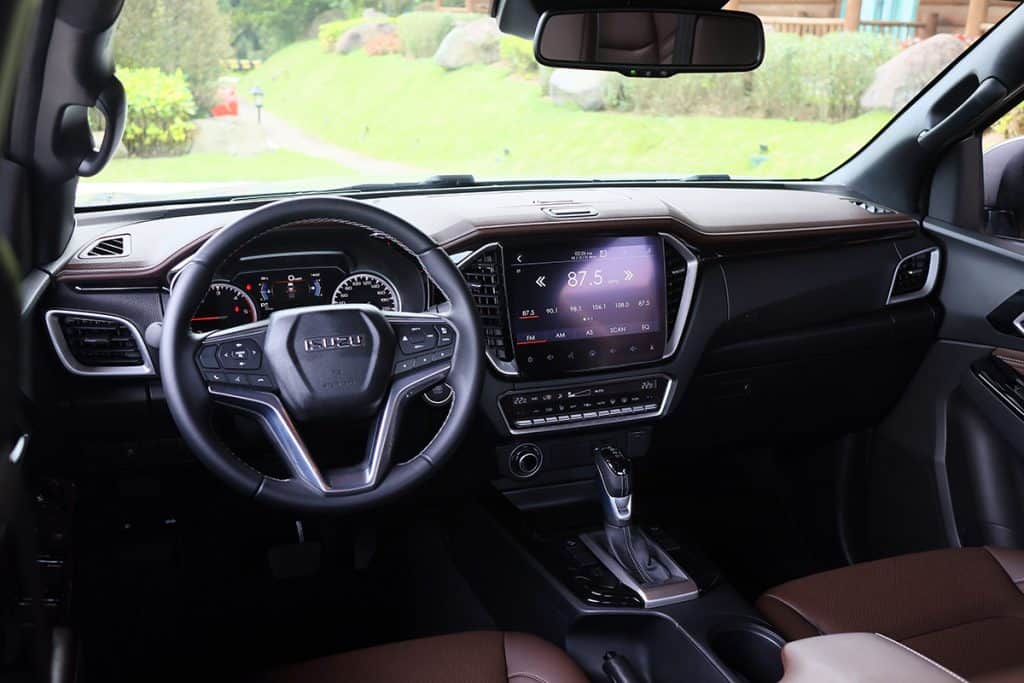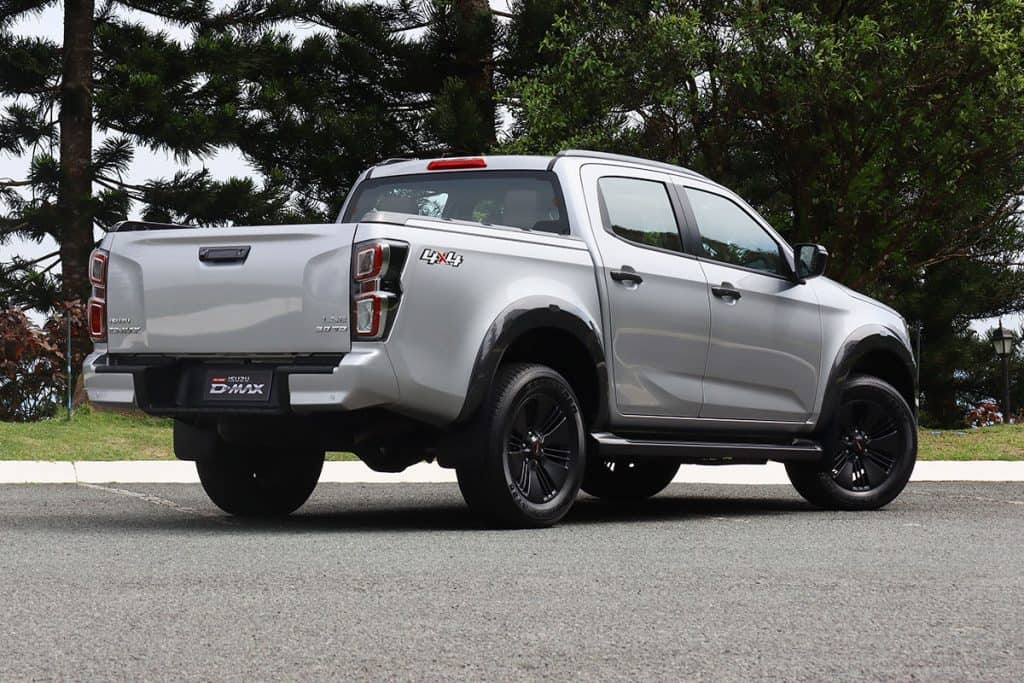Isuzu has had a lot of time to think about its D-MAX; after all, this is their first-ever full model change in about eight years. Instead of procrastinating, Isuzu got to work, honing and polishing every aspect. And it shows, because this pickup truck impresses.
Right off the bat, Isuzu scores a homerun. The D-MAX’s style is bold, modern, and assertive. Dimensionally, it’s smaller than the likes of the Hilux or Ranger, but those few millimeters don’t matter once your eyes lock on that front end. The angry headlights and fang-like grille all work to give it gravitas. Plus, the decision to drop all the chrome for the LS-E is surprising given the typically conservative nature of Isuzu, but it works. Those gun metallic elements on the grille, mirrors, door handles, and even alloy wheels give it an extra touch of menace.

Swing the door open, and it shows off its equally impressive interior. The black and brown colorway may not be to everyone’s liking, but it does manage to give it an upscale look and feel. The D-MAX can’t completely shed its workhorse origins—hard plastics can be found on the doors and lower dashboard, but the consistent texturing and soft dash topper can successfully avert your attention. Furthermore, all the switchgear are well-damped and feel crisp. Like the previous model, there are also a ton of built-in storage bins like the slide-out cupholder below the air vents and the dual glove boxes.

The seats, covered in low-rebound MDI polyurethane material, promote great support. They’re firm and hug the occupants in all the right places. The 8-way power adjustable seat and tilt/telescopic steering wheel also means it’s easy to find the right driving position. As with any other pickup truck, you sit high, even at the lowest seat height. Visibility is excellent all over thanks to the large windows and generous side mirrors.
Isuzus are known for their on-board entertainment, and the all-new D-MAX doesn’t disappoint. It comes with a locally fitted 10.1-inch infotainment system which comes with both Apple CarPlay and Android Auto out of the box. The screen resolution is sharp, though direct sunlight has a tendency to wash out the display. Drivers may end up having to squint at the display midday, but there’s no question that the speakers installed are the best in the business. Those unique ceiling-mounted tweeters aren’t just for show, they actually help.
Onto the business end of things, the all-new D-MAX is leagues ahead in terms of mechanical refinement compared to its predecessor—and perhaps even the Ranger or Hilux. Press the start button, and the speedometer and tachometer swings in an intricate dance along with the large multi-information screen. The 4JJ3-TCX engine is all-new, and it’s surprisingly quiet with an even, refined tone.
Spec-wise, it doesn’t lead the pack with its 190hp and 450Nm. But what it lacks in on-paper grunt, it delivers, convincingly, in real life. Peak torque is available from 1,600 to 2,600 rpm, but 88 percent of that number (400Nm) comes in from 1,400 to 3,250 rpm—virtually the entire operating rev range. With that, the D-MAX never needs to rev hard to get moving. True enough, even when climbing up steep inclines, the engine muscles through without a sweat. Plus, it results in a commendable fuel economy figure of 9.70 km/L (average speed of 20 km/h).
Even lovelier than the D-MAX’s powertrain is its platform. Among its peers, it is the only one that is completely new. Isuzu calls the underpinnings the Dynamic Drive Platform (aka Symmetric Mobility Platform). Featuring expanded cross sections of the ladder frame and the use of ultra-high-strength steel for the first time, it’s 23 percent stiffer than the outgoing model. With that, plow it through any road surface, and it will not flinch. Anything from small road corrugations to big potholes are dealt with quickly and assuredly. Even at the recommended 33psi front/36psi rear (for load-bearing) tire pressure, it is far more comfortable than the revised Hilux, for example. Drive it through uneven roads, and it feels secure and solid with no evidence of jarring or shimmies.

The new platform also means Isuzu has optimized the powertrain’s positioning. The engine has been moved slightly behind the front axle, and this has improved its overall handling and stability. Isuzu calls it a “semi-midship” layout, and whether this is due to Mazda’s input (this will be the basis for the all-new BT-50 as well), but as far as pickup trucks go, this one behaves well. Turn in isn’t as quick as you’d hope, but it is up there when it comes to cornering poise. Nothing knocks the sense of stability that this truck offers. For off-roaders though, it is worth noting that this top-trim 4×4 LS-E does not have a rear locking differential; it is a feature only found in the manual-equipped 4×4 LS.
Finally, understanding that safety is now increasingly important to pickup truck buyers (especially for high-trim variants), Isuzu’s given its D-MAX a leg up the competition with the introduction of Advanced Driver Assist System or ADAS. It adds features such as Forward Collision Warning, Autonomous Emergency Braking, Turn Assist, Adaptive Cruise Control, Lane Departure Warning, and Automatic High Beam Assist. Unlike radar systems mounted in the bumper or grille that can get messed up during off-roading, the pair of stereoscopic cameras mounted behind the windshield can always be cleaned by the wipers. Ingenious. Also, seven airbags are standard as well as ABS with EBD, stability control with Hill Start Assist, and Hill Descent Control. It’s this particular setup that helped the D-MAX score a perfect 5-star safety rating at the world’s toughest crash test: the Euro NCAP.
Improvements for new vehicles are typically incremental, but the rapid pace at which pickup trucks are evolving means Isuzu had to go big in order to battle for the lead. The all-new D-MAX does just that. Simply put, it’s a quantum leap in every respect. It won’t be surprising for Isuzu to gain a wider audience with this all-new model, especially those who value refinement and comfort just as much as capability and toughness.

